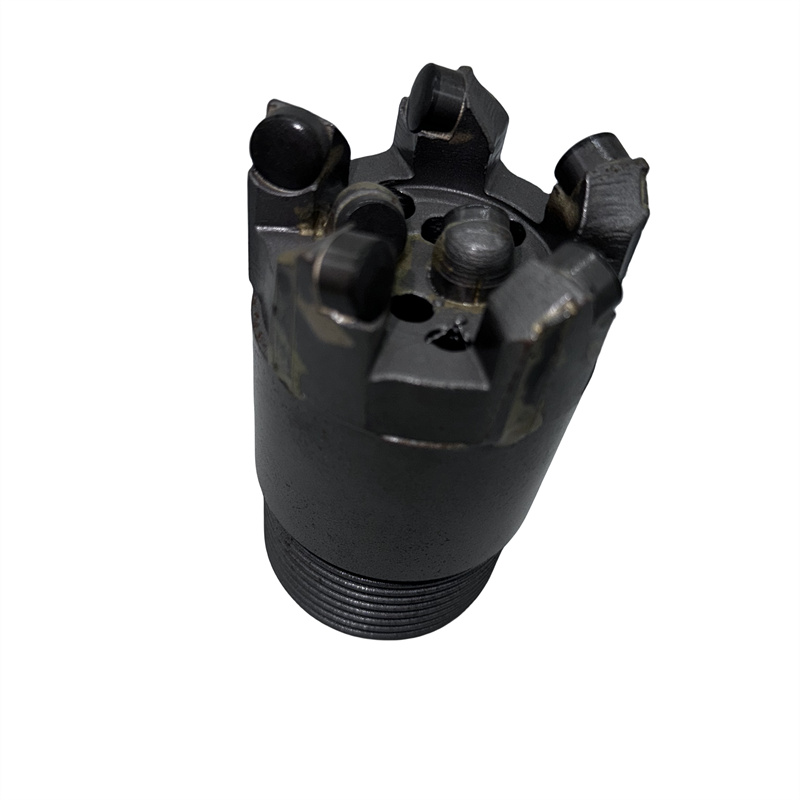How do you use PDC Five Wings Linear Concave Drill Bits
These "PDC Five Wings Linear Concave Drill Bits" are a type of drill bit where the cutters are fixed in place. PDC stands for Polycrystalline Diamond Compact, which is what the cutting parts are made of. These bits have five of those wing-like parts and a cutting face that is shaped like a line going inwards.

The way these drill bits are designed gives them some advantages for certain drilling jobs
1. Drilling Faster (Rate of Penetration - ROP):
That Linear Concave Shape: This helps the bit cut through the ground more effectively. It's like it has a more aggressive way of slicing, which can make it drill faster, especially in ground that is not too hard and not too soft. The curve helps get the rock bits out of the way better so the bit isn't just grinding over the same stuff.
2. Having Five Wings: Compared to drill bits with fewer wings, having more can spread the force more evenly across the bit. This can make it vibrate less and might even help it drill faster.
3. Being Stable and Easy to Control:
Because it has more wings, the drill bit stays steadier while it's making a hole. It doesn't wobble sideways as much, which means you get a straighter hole that's easier to control. This is really important when you're drilling at an angle or need to make a very precise hole.
4. Working Well in Certain Ground:
Ground That's Not Too Hard: The linear concave shape usually cuts through this kind of ground really well.
Ground That's a Mix of Hard and Soft: The curve can also help when the ground changes from hard to soft and back again, so the drill bit doesn't bounce around too much.
Less Jerking Around (Torque Fluctuations): The way the wings and the diamond cutting pieces (PDC cutters) are arranged can make the drilling smoother with less of that jerky twisting motion.
5. Lasting Longer: When the force is spread out evenly and the broken rock bits are cleared away well, the cutting pieces don't wear down unevenly. This can make the drill bit last longer.
Using these PDC Drill Bits involves the whole drilling process. Here are the main steps and things to keep in mind:
1. Getting Ready to Drill:
Picking the Right Bit: You need to choose the right type and size of PDC five-wing linear concave drill bit based on what kind of rock you expect to drill through, how hard and gritty it is, and what kind of hole you are trying to make (straight down or at an angle).
Checking the Bit: Look at the drill bit to make sure it's not broken, the cutting pieces aren't worn out or missing, and the little nozzles that spray fluid are clear.
Connecting to the Bottom Part of the Drill (BHA - Bottom Hole Assembly): You need to attach the drill bit correctly to the bottom part of the drill string. Make sure it's on there tight and secure. The design of this bottom part is really important for controlling where the hole goes and how well the drill bit works.
2. Actually Drilling:
Starting Slowly: When the drill bit first touches the bottom of the hole, start the drilling machine slowly. Gradually put more weight on the bit (WOB - Weight on Bit) and make it spin faster (RPM - Revolutions Per Minute).
Controlling Weight and Speed: Depending on how hard the ground is, what kind of drill bit you're using, and how the drilling fluid is working, you need to control the weight and speed carefully. Too much weight or speed can make the bit wear out or break too soon, and too little will make it drill too slowly. Usually, you need to look at what the drill bit maker recommends and what people with experience say.
Using Drilling Fluid: You need to keep pumping drilling fluid down the hole. It does a few important things: Keeps the Bit Cool, Gets Rid of Rock Bits, Keeps the Hole from Collapsing, Powers the Nozzles.
Watching the Drilling: Keep a close eye on the weight on the bit, the speed it's spinning, how much it's twisting (torque), the pressure of the fluid, and how much fluid is going down. This helps you know how the drill bit is working and what kind of ground you're hitting.
Drilling Smoothly: Try not to change the weight or speed too suddenly. Keep the drilling process smooth to help the drill bit last longer and make a better hole.
Dealing with Getting Stuck: If you hit some tricky ground or the drill bit gets stuck, you need to handle it the right way so you don't force it and break the bit.
3. Pulling Out and Changing the Bit:
When you have drilled as deep as you need to go, the drill bit is worn out, or you need to use a different kind of bit, stop drilling and pump drilling fluid to clean out the hole.
Slowly and smoothly pull the drill string and drill bit out of the hole. Don't bump or damage the bit.
Once it's out, check how worn the drill bit is. Figure out why it wore out the way it did. This helps you choose better drill bits and drilling settings for the next time.
Click The Link Below to Contact Us Today, And We Will Find The Perfect Drilling Solution For You!
PDC Five Wings Linear Concave Drill Bits
